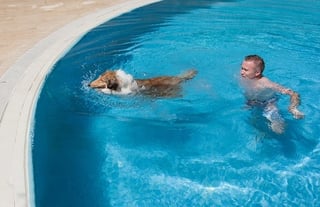—A guide to helping your pet learn to safely and comfortably swim

Thinking about teaching your dog how to swim? Great idea! Especially if you have a backyard pool for the whole family to enjoy. As with children, the skill of swimming can be a life-saver for your precious pet.
That means it’s vital to have a well-planned, thorough training process that gets Benji or Bella comfortable being in the water while the aquatic lessons commence. Realize, though, that all dogs have different personalities, as well as varying abilities to swim.
“It’s a pretty common misconception that all dogs are natural swimmers,” says Lina Eklof, dog training operations and training manager for Petco. “That’s not true. It’s pretty much a taught behavior. There are even some breeds that are physically unable to swim.”
Some have a natural skill, and some need instruction. For these reasons, advanced preparation—as outlined in this “how-to” article—is key before engaging in any water-based training with your furry friend.
Once you have a firm grasp on your dog’s ability, you can proceed with the hands-on training in your swimming pool. The process is explained in the following five steps.
1. Safely lead your dog into the pool.
If your dog seems nervous about entering the water, the best approach is a gradual entry. With that in mind, the first task at hand is simply to introduce your pet to water. The goal is helping man’s best friend feel at ease standing in the water.
Begin in the shallow end of your pool on the entry steps. There, Toto can easily stand with his head out of the water. Place a leash on him, and walk slowly onto the top pool step while gently encouraging him to follow you.
Based on your pool’s design and features, an even better spot than the entry steps may be available for this activity. If your entry steps are on the small side—particularly if your pet is large—but you have a nice wide tanning ledge like the one pictured below, it may be perfect for your pup to walk along to start enjoying being in the water. Note: A tanning ledge—also called a sun shelf or a Baja bench—is usually 6 to 12 inches deep.

Once your dog is on the step and appears relatively at ease, repeat the process. Lead your pet off the step to exit the pool, then immediately return to the step, then exit the water to the deck, and so on.
This repetition is important: It will help assure your dog that he can get out of the water, and it will help your pet become more accepting of re-entering it.
If your dog shows any hesitation or sign of nervousness, slow down the lesson. Get in the pool and gently encourage your furry friend to come in with you. Use plenty of verbal praise and physical affection and petting when he responds by venturing in further.
Enticing your pet with a favorite toy can help provide an effective distraction from any anxiety your pet may be feeling.
2. Advance deeper with a “step-by-step” technique.
Once your dog appears at ease and confident getting in and out of the water, continue the lesson by gradually going deeper in the water. Do so a single step at a time. Allow your pet to relax with each step, and only then progress to the next one.
If your dog is relatively small (or if you’re proportionally larger), here’s another approach to use instead of—or in addition to—the pool step: Use your body. Hold your pet in a fashion similar to how you might cradle a baby up against your shoulder. Then, walk slowly into the water, stopping along the way every few inches to monitor how Lassie seems to be doing as her body gradually becomes submerged.
Once she is on the second or third step (depending on your pet’s height) and submerged up to the neck, walk her back and forth until she gets used to being in the water.
Patience is key. Depending on your dog’s comfort level, you may need to repeat this part of the process over several days. If your pet is happy and wagging her water-logged tail on day one, you can advance to the next step. But if she appears wary and does not settle down after a few minutes, go slow. End the lesson, and pick it up the next day.
3. Provide support while your dog learns to paddle.
After your dog appears to be relatively secure with the water being neck high, it’s time for the next step. Slowly coax your pet and move into deeper water—so he must begin paddling to stay afloat. If you have a dog life vest on him, it will provide extra buoyancy.
Regardless if your pet has on a flotation device or not, if he struggles, you should immediately move to help him. Place your arm underneath his stomach and/or ribcage to provide additional support. The extra assistance will allow him to paddle with both front and back legs, which is the most efficient way for dogs to swim.
“It should look your dog is running in the water,” Petco’s Eklof says. “Some dogs may forget to use their back legs. If that’s the case, touch their back legs and they should start kicking with them.”
As your dog begins to paddle, make sure he keeps his head up while extending the neck forward. This position enables him to maintain clear vision and to breathe easier.
Once your pet starts getting the hang of paddling, slowly remove your arm from underneath. Incrementally reduce your support. Again, go slowly until your dog is paddling on his own without your help. Stay right next to him at all times, in case he begins struggling and needs you to reestablish support.
Keep expectations reasonable. Now is not the time to see if he can do laps across the length of your pool! Unless he takes off like a four-legged Michael Phelps, limit the time of his first swimming endeavor. Keep the session short, and remain in one area of the pool near the steps and shallow end.

4. Teach your dog how to exit the pool.
The steps on a pool are designed for human use. Therefore, don’t assume that your dog can safely follow them to exit the pool without being shown how. Teach your pet where the stairs are and how to use them to get out of the water on his own.
Start by using the leash to gently lead your dog up the steps and out of the pool. Repeat this several times. Once your pet can swim well and knows how to use the steps, it’s time to see if he can do it on his own.
First, position another family member at the top of the pool steps. Enter the pool with your pet, and lead or carry him a short distance away from the steps. Now, let go—while having the family member call your pet from the top of the steps to come out of the pool. Once your pet has the exit path down, repeat it several times that day.
Navigating the exit can save your dog’s life. To ensure your pet knows the way out, repeat this lesson over a number of different days. Practice by having your dog enter the water from different locations so he can learn to find the steps from anywhere inside the pool. A month later, test again for reinforcement.
If your pool boasts a tanning ledge, it’s a good idea to show your dog this additional option for a shallow perch from which to get out of deep water and climb out of the pool.
5. Expand and reinforce the training.
Throughout the lesson, give your dog plenty of verbal and physical praise—and maybe an extra treat afterward. Doing so will help your pet associate fun and positive times with the experience of swimming.
To ensure that your pet can swim safely and comfortably across the entire pool, have him practice swimming in different parts of the pool. To make it more fun, you can throw a ball or other doggie toy for him to retrieve and swim back to you. Be sure to throw the ball into all areas of the pool, including the deep end, to see how quickly he can locate and reach the exit.
Some dogs can be taught to swim in only one lesson; others may require several to become adept in water, according to experts.
“Keep the lessons short—maybe three to five minutes,” Eklof says. “Settle them down on land after a lesson, and then go back in. Do maybe four to five lessons in a day, but don’t exhaust the dog. You should be aware of their stamina, because some will just keep going if you don’t stop them.”
If your pet is a quick learner, it’s still a good idea to practice a few more times over several weeks. As with any instruction, repetition helps fortify all that good training.
Even after your dog learns to swim and becomes confident in the water, never leave him unattended in the pool. Pets can tire, swallow too much water, or get too cold—all of which can lead to accidental drowning.
Tip for pools with traditional chlorine:
According to the American Kennel Club, it’s a good idea to rinse off your dog after every swim to remove chlorine and other chemicals that may linger on his coat—especially with longhaired breeds. Gently drying the insides of the ears with a soft towel can also help prevent ear infections. (Pool builder advice: An even better solution is to sanitize pool water with a gentle, virtually chlorine-free purification system.)

The Takeaway:
No family should have to lose a pet to a preventable drowning. Airbud, Rover, and Goldie are like family members, so you want them to be able to safely enjoy your backyard resort with the rest of your family.
Train your dog how to swim and to safely exit the pool. And never leave pets unattended in or around the water—no matter how well they can swim.
To learn even more about keeping your dog safe in and around your backyard pool, check out this article.




.jpg?width=1490&name=rock-waterfall-slide-pool%20(1).jpg)